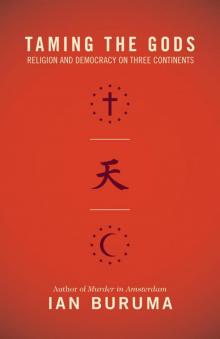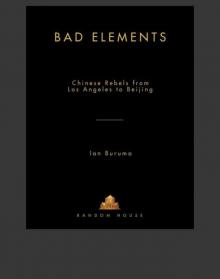- Home
- Ian Buruma
A Japanese Mirror Page 14
A Japanese Mirror Read online
Page 14
A large number of men, one is told, go to the toruko to be babied. There are even certain establishments where the customers literally dress up in diapers so that they can make a mess and cry for mama.36 Mama then cleans up and bathes them, clucking and cooing in baby-talk. These places are somewhat specialized, however, and though perhaps symptomatic, not common enough to be representative.
One does not have to go that far, though, to see the mother-figure looming. In The Pornographers, a novel by Nosaka Akiyuki, later made into a film by Imamura Shohei, there is a hilarious description of a visit to a toruko by one of the main characters:
‘You lie down on one of those massage tables like a baby. You then close your eyes without thinking of anything, leaving everything to the woman. It doesn’t matter what she looks like or what she’s thinking. With her fingers she looks for the most sensitive spot on your body, a spot you didn’t even know yourself, that your own wife didn’t even know. That’s the best part of the “special treatment”. Only the man feels good with the “special”. The woman isn’t allowed to feel anything. In short, it’s as if you’re treated by your own mother … Mother love is, how shall I put it, well, you know, service, sacrifice. All this is a bit cruel. When you climax, the woman must pretend to be shocked and then wipe you clean. At that moment she really is your mother. You wrap your arms around her. She won’t mind what you do, just like a mother and child.’
Mother and child. That, once again, is the primal element. But fantasy women are not necessarily divided into mothers and whores: they can be one and the same; the whore often really is the Madonna. Not for nothing are prostitutes traditionally sometimes compared to Buddhist deities, such as Kannon, the Goddess of Mercy.
There is a widely read comic-strip by a celebrated comic artist called Kamimura Kazuo. It first appeared in 1977, but the story actually takes place in a Tokyo brothel area of the early 1950s and thus it is filled with nostalgia. The main character is Sachiko, the sweetest of maternal prostitutes. Like most suffering heroines Sachiko lost her parents soon after she was born. She was also raped by a big, bad American soldier during the occupation: this cliché is almost a required badge of courage, like a duelling scar on a pre-war German Korps Student: no fate could possibly be worse, so the heroine starts off with the reader’s deepest sympathy.
In her more melancholy moments, Sachiko likes to think of her parents and she sings her favourite song:
I’m the blooming flower of the red-light quarter
If the moon were a mirror
I’d stand in front of it
So my dear lost parents could see me once again.
Sachiko is a good woman and like many sensible Japanese girls, she combines the practical with the maternal. She takes on students at reduced rates and even does their dirty washing for them, reasoning that ‘of all the students who use my body now, at least one will end up as a company director and then surely he will take care of me’.
One day a student arrives, asking for the madam, a sour-faced woman always thinking of money. Sachiko offers the boy a cup of tea in her room and tells him all about the madam. He gets more and more agitated until in a fit of hysterics he bursts out: ‘It’s her! It’s her! After fifteen years, I’ve found her! Mother! Mother!’
The following scene is identical to the one in ‘Mother Behind My Eyes’: the student, like Chutaro in the play, is delirious. He howls and cries but his mother refuses to recognize him, telling him to leave at once. How dare he play tricks on an old woman, obviously trying to get at her money. Again like Chutaro, the boy laughs hysterically and screams: ‘How could I have been so stupid, spending all these years looking for nothing, all for nothing!’ Perhaps the author did not steal this scene consciously, but it does show that the horrifying possibility of maternal rejection works again and again.
Sachiko comes to the rescue. She takes him to her room and whispers in her sweetest voice: ‘I’ll be your mother instead. That’s what I live for.’ She proceeds to spread her legs as wide as they will go, inches in front of his tear-streaked face, just like in the striptease-parlour. ‘Take a good look,’ she coos, ‘this is what they call a man’s home. I’m your home, my dear boy, I’m your mother.’
‘Oh,’ he murmurs, and breaking into baby-talk, he asks, ‘can I suck your breasts, Mummy?’ The story ends with a close-up of Sachiko’s breast cradling his sleeping head. Sachiko ponders: ‘That night the old madam’s son came in my body. Now he’s sound asleep, looking so serene. At that moment I was happy too; perhaps one day I too shall be a mother … ’
Sachiko’s Happiness (Sachiko no Sachi), for that is the title of this comic, is a serious work. The point is not to titillate so much as to move. It is a tearjerker, a three-handkerchief comic-book. It is read in Japan, not just by the young, but also by highly educated adults. It is certainly not thought to be strange in any way that the sentimental heroine is a prostitute; on the contrary, it is deemed quite appropriate.
Real sexuality would upset the pure, suffering-mother image. Sachiko has sex, of course, for that is the prostitute’s trade, but, as Nosaka’s character said, she does not feel anything. Sex is just an instrument to make men feel good.
In another Sachiko comic an elegant kimonoed lady turns up at the brothel. She very politely asks the madam whether she could possibly work at the brothel for nothing. She would be happy to hand over her earnings. All she is interested in is the sex. The madam is naturally delighted with this arrangement. And the elegant lady gets carpenters and decorators to turn her shabby room into a veritable palace of pleasure.
Sachiko and the other girls are so upset by this turn of events that they decide to go on strike. But the newcomer proves to be insatiable. She has one rule only: she refuses to see any man more than once. This is too much to bear for one particular client who is driven half insane with frustration. Things then take the inevitable nasty turn: the man rushes into her mirrored boudoir and stabs her hysterically with a huge kitchen knife. Her gory death is depicted in all the graphic detail the Japanese comic reader is accustomed to: in a series of illustrations we see the knife go in and out, in and out, blood staining the double page like a horrible Rorschach test. The lady dies with an angelic smile fixed on her elegant face.
The passionate forces she unleashed have run their course and everything reverts back to normal again. The prostitutes get back to work. ‘I never want to be like that woman,’ thinks Sachiko, ‘I never want to see that female Hell.’
Sachiko is anything but sexy, the opposite of the femme fatale. It is her maternal sweetness, her yasashisa, that makes her a popular heroine. There are examples of this phenomenon in real life too, which takes us back to the striptease parlour once again. In the early 1970s there was a sudden vogue for a stripper called Ichijo Sayuri, a pleasant, but unremarkable-looking woman from Osaka. At the height of her fame she was suddenly arrested on obscenity charges. Her exposure on stage was no different from any other stripteaseuse’s, but she had become too famous – it was all too public, the boat had been rocked. The news of her arrest was received with storms of protest, especially in ‘interi’ circles: journalists, writers and film-makers all came to her defence. A modish director even made a film about her life called ‘Ichijo Sayuri–Wet Desire.’
Why was there this tremendous surge of popularity? I think a film reviewer stated the answer when he wrote that ‘it was only her sweetness that made Ichijo Sayuri so much loved. There is a scene in the film about her of a truck-driver wildly masturbating while watching Ichijo’s exposed genitals in a striptease parlour. She leans over to him and enquires in the kindest voice whether he is doing all right. “Yes, yes!” he answers, his eyes filled with gratitude. This tenuous sexual rapport turns into something beautiful because of her gentleness. Now the authorities even want to rob us of that.’37
It is as if ‘the authorities’ are like a Victorian father taking the good mother away from the people. The rules of society are always threatening the innocent child at play. This
view of sexuality might help to explain the constant, almost palpable, erotic tension in Japan. Far from the cynical knowingness that pervades sexuality in the West, it is an adolescent tension one feels, a knot of insoluble contradictions.
It has existed for centuries, this itchy combination of social frustration and innocent sensuality; of pervading sexuality and deep anxiety. It is, of course, partly due to the universal human condition, but it is perhaps felt more extremely in Japan, which is at once the most natural and the most artificial of places. The Japanese are both intensely physical and extremely fastidious. It is the extreme character of these contradictions rather than their uniqueness that makes Japan as erotomanic as it so often appears to be.
The frustration has probably grown worse. The social brakes are still there, while the traditional outlets – for men at least; women never had many outlets – have become less available. In the last few years clever businessmen have capitalized on this situation by introducing an endless variety of sexual gimmicks. One in particular appears both typical of traditional attitudes and of contemporary society. The leading role is played by yet another version of the Japanese doll-woman.
This fantasy woman is the star of the nopan kissa:38 nopan is an abbreviation of ‘no pants’, and kissa, short for kissaten, means coffee shop; in other words, a coffee shop where the waitresses wear no underclothes. The craze for this caught on in the summer of 1980, starting in Osaka, home of the lucrative gimmick. Within a few months every Japanese city was full of them, not just around the less salubrious railway stations, where one might expect them, but in the most fashionable shopping areas. They are decorated on the outside with pin-ups from magazines, polaroid pictures of the bare-bottomed waitresses, dingy neon lights and large posters with details of the specialities of the house: ‘Stewardesses with no pants!’, ‘Porno video on the premises!’ All this to drink a cup of coffee.
The customer is ushered inside by a young man in patent leather shoes and a cheap satin kimono draped over his Western-style suit. ‘Welcome to our shop!’ he shouts through a plastic megaphone. Inside the visitor is courteously greeted by two plump girls, naked apart from their minuscule skirts and two dainty ribbons wrapped around their necks like Christmas presents. ‘Welcome inside’, they pipe in perfect unison.
The decor is remarkable. Not only are there the usual pin-ups on the walls, porn comics on the coffee-tables and beeping, buzzing invader games for those who might get bored with staring at the waitresses’ legs, but suspended from the ceiling are at least a dozen inflated condoms like balloons at a children’s birthday party. The walls are further embellished with various articles of female underwear, such as stockings, panties and garter belts. There is also a sign that reads: ‘Do not speak to the waitresses. Do not touch them. Do not bother them in any way’.
The customers pay about $7 for one cup of coffee. Is there perhaps more to this than meets the eye? Not necessarily. What meets the eye in Japan is often all there is. Japan is, after all, as Roland Barthes observed, the empire of signs, the land of the empty gesture, the symbol, the detail that stands for the whole. The fetishist ikon is so powerful that the real thing becomes superfluous.
There is something childlike about these men ensconced in the sticky imitation-leather chairs of the nopan kissa: sitting in groups, dressed in suits and ties, most of them in their thirties, giggling nervously, bobbing their heads up and down like yo-yos every time a waitress bends down to serve a cup of coffee. Bothering the girls seems to be the last thing on their minds.
The climax, if that is the word to use, of the visit is an auction of one of the girls’ panties. The girl, fully dressed now, climbs up on one of the tables, looking faintly bored with it all, like a life model in an art class. The men cluster round, jostling each other for the best vantage point.
While a male employee shouts through a microphone, the girl slowly peels her clothes off, until she is only in her panties. The bidding then goes higher and higher and the voice through the microphone gets progressively louder. Finally the winner is allowed, for a considerable fee, to slide the panties off the girl’s goose-pimpled legs, all the time nervously glancing over his shoulder at his friends, who are still nudging and pushing each other.
The men pay for their coffee and file out of the shop. One of the girls stands by the exit and one by one the men are invited lightly to squeeze one of her breasts, almost brushing the cash-register, just once. All the girls make a bow and say in mechanical unison: ‘Thank you for patronizing our shop. We do hope we will have the pleasure of your company again.’
It might not quite match the aristocratic style of the Heian court, or the elegance of the floating world in Edo, or even the dashing teahouse of Meiji, but it does prove that even at the summit of sexual exploitation the Japanese have not quite lost their sense of manners and decorum.
7
The Third Sex
In the spring of 1914 Kobayashi Ichizo, former director of the Hankyu Railways, built a paradise on earth; about fifty miles from Osaka, in a sleepy hot springs resort called Takarazuka. It is rather a special kind of paradise, for its only inhabitants are girls, young girls. Its main attraction is the Takarazuka Young Girls Opera Company.
Kobayashi built the first theatre in a large swimming pool appropriately named Paradise. Because every collective venture in Japan needs a slogan Kobayashi thought of one too: ‘Kiyoku Tadashiku Utsukushiku’. Pure Righteous Beautiful. And to this day the all-girl revue consists of pure, righteous and beautiful girls from the best families in the land. They live a cloistered existence in Takarazuka, segregated as much as possible from the sordid reality of the world outside. They are the official angels of paradise.
The angels are actually called ‘students’, never actresses, dancers or, perish the thought, showgirls. They are taken on at a very early age, usually around fourteen, after strict selection. Then, living in the Violet Dormitory, strictly off-limits for men, they are taught all the necessary skills of respectable young Japanese ladies, such as flower-arranging or the tea ceremony, as well as singing and dancing.
If one of the students should want to get married, she is automatically expelled from paradise. A married woman can be righteous and no doubt beautiful, but not pure. Takarazuka is pure virgin territory. The oldest star, a woman in her seventies, is not called The Eternal Virgin’ for nothing.
One of the first things to strike the visitor to Takarazuka is the overwhelming predominance of pink. To reach the theatre the visitor crosses a pink bridge; the theatre itself is pink, and so is the foyer, and the halls to the dressing room, the cable cars that travel high over the ‘street of flowers’, the lunch boxes in the restaurants; and most of the girls in the audience are dressed in pink. If one can make the comparison without sounding blasphemous, the inside of the Takarazuka theatre reminds one of the pink interiors of Japanese striptease parlours; it has the same womb-like quality.
The architecture of paradise is interesting too: a kind of Disneyland Swiss village: little chalets and chocolate-box houses bearing such names as Ladies’ Inn, Ladybird Café and, perhaps most apt of all, Illusion.
Apart from the wartime years, during which the Takarazuka stage was filled with pure, beautiful and righteous girls in army uniforms singing the praises of Japanese guns and brotherhood in Asia, the company has specialized in romantic musical revues, home grown as well as such foreign favourites as ‘Gone With the Wind’ and ‘Romeo and Juliet’.
There are of course no men in the troupe. This is one of the outstanding features of the Takarazuka style; the girls playing the male parts are the stars, adored by fans all over the country. All Takarazuka members wear their hair short like freshly scrubbed schoolboys and it is the dream of every one of them to get to play a man. The ‘male’ stars are so popular that fans staged a protest demonstration when one of their idols was required to play Scarlett O’Hara: ‘They’ve turned Maru into a woman!’ they screamed.
Watching the Takarazuka stude
nts rehearse the male roles is a fascinating experience. It is all based on kata, formal patterns, just like in the Kabuki theatre. A series of formalized masculine postures is rehearsed over and over again until the girls get it just right. The older girls act as models and drill instructors for the younger ones. Apparently many of these postures were originally developed in the 1950s when senior members of the troupe diligently copied poses from Marlon Brando movies.
What is behind all this? Why this enthusiasm for transvestite theatre? I asked a Takarazuka producer (the producers, directors, composers and choreographers, typically, are all males). He answered that it was surely healthier for young girls to idolize Takarazuka stars than those long-haired pop groups. Besides, he thought, girls of that age feel safer that way: They are too bashful to scream and shout at real men, even if they felt so inclined.’ This is possible. But then he raised another, to me more fundamental point: ‘It’s a bit different these days, but before the war it was hard to find boys beautiful enough to suit the ideals of our audience.’
Not beautiful enough; in other words, no real man can ever be as beautiful as a woman playing a man, just as no woman is quite as stunning as a skilful female impersonator. This goes to the heart of Japanese aesthetics and just like the geisha, the female work of art, it is based on the principle of depersonalization.
As is the case in most cultures, the tradition of theatrical transvestism goes back a very long way in Japan. And like the theatre itself it has religious origins. When the Sun Goddess met her unruly brother Susanoo, she dressed up in male clothes. Cross-dressing certainly played a part in sacred rites and festivals. Female shrine dancers (aruki miko), who were often also prostitutes, dressed up as males, just as during the Edo period male geishas were trained in feminine arts.1
Sexual ambivalence is an important element in the Buddhist tradition too, as Lévi-Strauss explains in Tristes Tropiques: ‘[Buddhism] expresses a placid femininity which seems to have been freed from the battle of the sexes, a femininity which is also suggested by the temple priests whose shaven heads make them indistinguishable from the nuns, with whom they form a kind of third sex …’ Buddhist sculpture often expresses a kind of androgyny, transcending the sexes.2 Kannon (Kuan Yin in China, Avalokiteshvara in India), the Goddess of Mercy, actually changed her sex. She started off as a god in India and in time, gradually moving further east, she became a goddess.

 A Japanese Mirror
A Japanese Mirror Taming the Gods
Taming the Gods The China Lover
The China Lover A Tokyo Romance
A Tokyo Romance Theater of Cruelty
Theater of Cruelty Year Zero
Year Zero The Wages of Guilt
The Wages of Guilt Murder in Amsterdam
Murder in Amsterdam Bad Elements
Bad Elements Their Promised Land
Their Promised Land Occidentalism
Occidentalism Anglomania
Anglomania Inventing Japan: 1853-1964 (Modern Library Chronicles)
Inventing Japan: 1853-1964 (Modern Library Chronicles) The Missionary and the Libertine
The Missionary and the Libertine